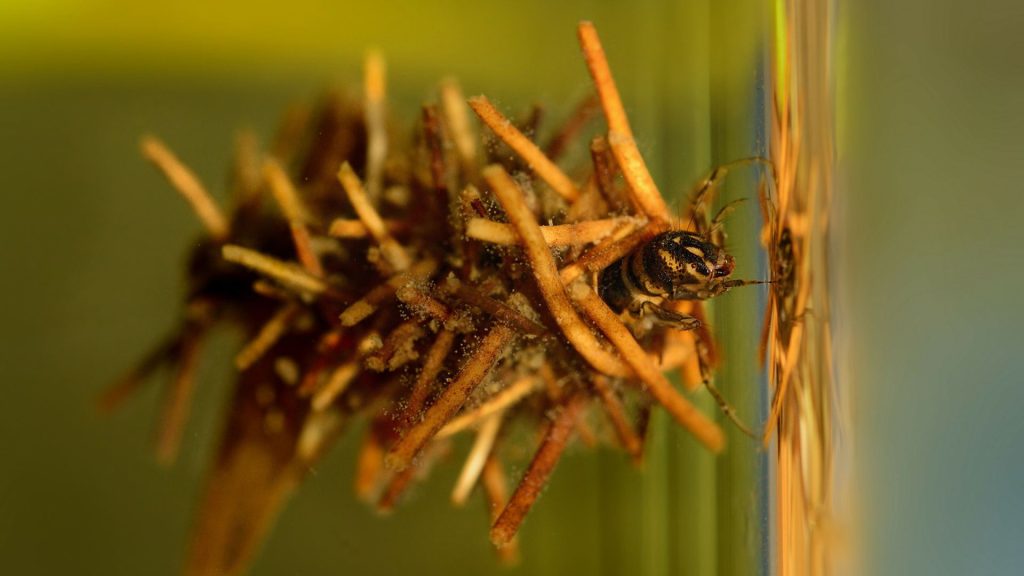Those of you familiar with the Alabama Water Watch program may not be surprised that the first article of the 12 Months of Aquatic Critters blog series features the critter on our logo: the caddisfly!
Caddisflies are a large group of insects with an aquatic larval stage. There are around 1,500 species of caddisfly in North America alone and over 14,000 species worldwide. Caddisflies are an important food source for many freshwater fish. In fact, both larval and adult caddisflies are often imitated as lures in fly fishing. Caddisflies can be found in a variety of colors including gray, brown, purplish brown, yellowish tan, and green. These critters have a low tolerance for water pollution and are typically found in higher quality sites with medium to fast-moving water.

As larvae, caddisflies have slender, segmented abdomens that resemble caterpillars. Their legs often have modifications such as hooks, hair tufts, or sharp endings. The abdomen ends with a pair of prolegs (a fleshy, stub structure) that oftentimes has claws. This helps caddisflies anchor themselves. Most larvae are between 0.5 inches to 1 inch long, although some are much smaller.
Many species construct protective cases made of pebbles, plant fibers such as leaf and stem pieces, and even unoccupied freshwater snail shells. Their saliva is a silk-like thread that is used as glue to hold the cases together.

French artist Hubert Duprat has used caddisflies in a living exhibit where they were kept in aquariums with only precious metals and jewels to construct their cases. The results are stunning!

Alternatively, some caddisflies species are “netspinning.” As the name implies, these caddisflies spin nets from small pieces of leaf detritus and/or animal parts from the water column that results in stretchy mesh webbing that moves readily with the water’s current. Oftentimes, you can find these caddisfly nets by turning over submerged rocks in a creek. The Stroud Water Research Center has an entertaining video of these netspinning caddisflies in action.

Some species of caddisflies do not construct protective cases nor spin webs and are known as “free-living,” such as the caddisfly portrayed in the Alabama Water Watch logo. This particular type of caddisfly is a member of the genus Hydropsyche which means “water spirit” in Latin. Most of the free-living caddisflies are predators.

Adult caddisflies spend their life stage above water. When the larval stage of the caddisfly has come to an end, they swim to the water’s surface, undergo a final molt, and begin exploring the skies. The adults only live for a few weeks, do not eat (in fact, they don’t even have mouthparts!), and focus solely on reproduction. Oftentimes caddisflies emerge en masse and swarm, inundating a particular area with so many adult individuals that predators cannot dream of consuming them all. Adult females return to the water to lay their egg masses, and the caddisfly life cycle starts all over again.

EPT Index
The EPT Richness Index is a commonly used tool by biologists to measure water quality. EPT (Ephemeroptera [mayflies], Plecoptera [stoneflies], and Tricoptera [caddisflies]) is an estimate of relative abundance of three major orders of stream insects that have low tolerance for water pollution. Let’s briefly discuss the “EPT friends” of the caddisfly.
Stoneflies (Plecoptera)

Stonefly larvae have segmented, flattened bodies to resist water current and lurk under river rocks and debris. They have two antenna-like “tails” called cerci, long antennae, and tuft-like gills typically found at the bases of their legs. Most stonefly larvae eat plant material. Larvae normally emerge during the summer, after 1-2 years underwater, to molt and emerge as a winged adult, similar to the caddisfly. Eggs are deposited on the water’s surface and adults die shortly after reproducing.

Mayflies (Ephemeroptera)

Mayfly larvae have slender, segmented bodies with feathery external gills on the sides and/or on the upper abdomen. The larvae have small eyes and a flattened head that helps them stick to underwater rocks in fast currents. Most mayfly larvae have three cerci from the tip of their abdomen. Larvae predominately eat algae and other small plants.

Mayfly adults are the only insect that undergoes two “adult” molts – with the first molt revealing a winged, sexually immature subadult and the final molt occurring within hours that reveals the sexually mature adult. Adults are also slender with obviously veined wings, short antennae, and large, compound eyes that resemble dragonfly eyes. The adults have two, long cerci and oftentimes extend their front two legs when resting. Adults only live a few days, and like the caddisfly, focus solely on reproduction in adulthood. Mayflies also emerge in swarms which can create fish feeding frenzies.
Alabama Water Watch teaches citizens how to sample for EPT and other aquatic macroinvertebrates (such as freshwater snails, crayfish, worms, midges, larval damselflies and dragonflies, water pennies, etc.) through our Stream Biomonitoring method. Sampling involves using a kick seine, buckets, dip nets, and sorting trays.

Do you have photos or videos of caddisflies, stoneflies, or mayflies? If so, share them with us using the AWW Photo/Video Submission form.

Thank you for writing this. It is FASCINATING and informative.